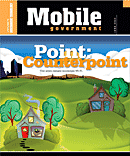|
|
 |
  | |
|
| ||
Optical Wireless SignalsMulti-rate, ultra-short laser pulses -- with wave forms shaped like dolphin chirps -- offer a new approach to help optical wireless signals penetrate clouds, fog and other adverse weather conditions, said Penn State engineers. The new approach could help bring optical bandwidth, capable of carrying huge amounts of information, to applications ranging from wireless communication between air and ground vehicles on the battlefield, to short links between college campus buildings, to metropolitan area networks that connect all the buildings in a city. Mohsen Kavehrad, the W. L. Weiss professor of electrical engineering and director of the Center for Information and Communications Technology Research, leads the study. He said, "The multi-rate approach offers many advantages. For example, lower-rate signals can get through clouds or fog when high rate signals can't. By sending the same message at several different rates, one of them can probably get through." Rather than slowing communication down, the multi-rate approach has been shown in tests to achieve an average bit rate higher than conventional optical wireless links operating at 2.5 Gbps as well as providing an increased level of communication reliability by maintaining a minimum of one active link throughout channel conditions, he added. Kavehrad outlined his team's new approach at the Optics East 2004 Conference in Philadelphia Oct. 27 in a paper, "Ultra-short Pulsed FSO Communications System with Wavelet Fractal Modulation." He also will describe the system at the IEEE MILCOM conference in Monterey, Calif., on Nov. 1. His co-author is Belal Hamzeh, doctoral candidate in electrical engineering. In optical wireless systems, also known as free-space optics (FSO), voice, video and/or data information is carried on line-of-sight, point-to-point laser beams. Outdoor FSO systems have been in use for more than 30 years but are hampered by weather and other obstructions that prevent the transmitter and receiver from "seeing" each other. Kavehrad explained that clouds and fog often clear abruptly providing brief windows for transmission, making pulsed delivery better suited to FSO. The new Penn State approach embeds data in ultra-short pulses of laser light, shaped via fractal modulation as wavelets, and then transmits the wavelets at various rates. Belal said the wavelets are easy to generate. "We use holography to generate and separate the wavelets. You just generate the mother wavelet and then the others can be generated as a fraction of the transmission bit rate of the mother. They can all co-exist in the channel without interference," he noted. The wavelets used by the Penn State team are Meyer's Type, which look like dolphin chirps. The wavelets minimize bandwidth waste and the ultra-short pulses are less likely to interact with rain or fog that could degrade the signal. The researchers note that their proposed system ensures on-the-fly operation without the need for significant electronic processing. The project is supported by the Air Force Research Laboratory.
News
Staff Related Supplements |













.gif)


